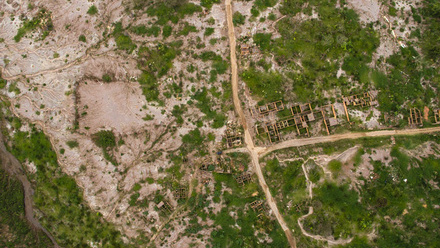How the UK planning and environmental permitting systems work for minerals
This section outlines some principles for administration of mineral operations through the planning and environmental permitting systems and mentions statutory nuisance.

This guide is a simplified summary. For comprehensive and definitive information, it is necessary to consult the legislation and guidance published by Government and its agencies.
Principles
Some key principles are that -
- all mineral workings require planning permission issued by the relevant Minerals Planning Authority (MPA) - the mineral planning authority is the County Council where these still exist and in other areas is the unitary (all purpose) local authority – the District or Borough Council – or the National Park Authority
- MPAs prepare policies for minerals operations in their areas that should conform with national policies
- planning applications should, in general, conform to both national and local policies but should be considered on their merits
- careful examination of environmental and community impacts is required for all mineral extraction proposals and permissions should be given only if these can be reduced to acceptable levels
- control of some aspects of the environmental impacts of mineral workings (in particular impacts on the water environment, other possible sources of pollution and the management of mineral waste) is the responsibility of the Environment Agency (EA) which issues licenses that are subject to legally enforceable conditions
- planning permissions are also subject to legally enforceable conditions to control operations and to secure restoration to an appropriate subsequent use when working is completed
- mineral extraction is a temporary use of land but, although some operations may last only a few years, others may continue over a much longer period, even for several decades. In law, mineral operations are a continuous process of development from the start of site preparation to the conclusion of restoration and after-care activities, and
- all mineral planning permissions either include an end date by which operations must cease or, if the permission does not contain a specific date, mineral operations must cease by 2042.
The main elements of the minerals planning and environmental permit systems are -
- national planning law, policy and guidance
- local planning policy
- planning decisions, and
- European Union and national environmental law, regulations, and permits.
National planning policy is contained in the minerals chapter of the National Planning Policy Framework. Planning Policy Statement 10 Planning for Sustainable Waste Management, while dealing with all wastes, contains guidance relevant to recycling of minerals and mineral products. These can be found in the National Planning Policy Framework (NPPF).
Planning policy
Mineral Planning Authorities (MPAs) are responsible for minerals planning in their areas. They must balance the economic need for minerals with protection of communities and the environment. They are required to draw up and consult on minerals plans which set out policy options.
Options must be subjected to sustainability appraisal to identify which of these the MPA considers best meets the social, economic and environmental objectives for the area concerned, taking into account all the relevant circumstances. In preparing their plans MPAs are required to set out how they intend to involve the public in developing their policies and in commenting on their emerging proposals.
Mineral working is destructive of the environment at the point of extraction. It is therefore very important to contain its impacts and mitigate them as far as possible. The sustainability process therefore includes the preparation of a Strategic Environmental Assessment, as required under European law.
This examines all the possible the impacts of the MPA's proposals on the environment, to help identify areas that are suitable for development and those that should be protected. Impacts to be considered may include, where necessary the effects on human health of mineral working, and from transporting minerals away from mines and quarries.
The results of the process are published for public consultation together with the MPA's draft ‘development plan document’. Key elements in development planning are a strategy (setting out the vision for mineral working in the plan area and strategic policies for the minerals involved), criteria for the identification of sites suitable for mineral working, and/or the allocation of specific sites, and policies for ‘development management’ – that is, the considerations governing the grant of individual permissions and the conditions that may need to be attached to them to mitigate any adverse impacts to levels at which the mineral working concerned can be judged acceptable.
County Councils produce plan documents either relating just to minerals or to minerals and waste development, for which they also have planning responsibilities. Unitary authorities may deal with minerals as part of their general development plan documents, but they can choose to produce minerals-specific documents, for example where there are substantial or complex issues to deal with. But in these cases, minerals development will still need to be consistent with relevant general principles in the authority's overall strategy.
After a period of consultation on planning issues and options, and on draft policies, the results of the consultation are considered and as appropriate taken into account in drawing up revised draft final plan documents. These are examined in public before an independent planning inspector before being modified, if necessary, and then approved. The inspector will test the plan for ‘soundness’. Tests include -
- Is the plan legal? – does it meet all relevant requirements?
- Is the plan justified? – have the public been properly involved, is it based on verifiable facts and have alternative options been properly considered?
- Is the plan effective? – are its proposed policies deliverable, are they sufficiently flexible to accommodate changed circumstances and are the proper monitoring arrangements?
- Does the plan conform to all relevant national policies?
The aim is to ensure that all the relevant issues have been properly considered, that the approach to managing demand for and supply of minerals located in the plan area, and due regard has been given to containing any environmental impacts to an acceptable level. Consideration of the plan includes assessing the possible combined effects - ‘cumulative impacts’ - of various types of development in the area, impacts outside the administrative area, such as 'exporting' of impacts via road, rail or shipping, the availability of alternative materials, and options for reducing the need for extracting new mineral to meet demand.
Site selection documents, or sections in combined plans, point out where mineral resources exist and list the criteria that should be addressed in any application for working. Site allocation documents will, if prepared, be more specific, identifying areas in which minerals working might be acceptable or preferred, but only if applications are well designed and meet the requirements for development management. An application for permission at a site that meets the selection criteria, or for a site identified in an allocation document, does not absolve the applicant from complying with all other relevant requirements.
National planning policies also require that mineral deposits are safeguarded from other forms of development which, if granted, might then become a factor against nearby mineral working, thereby ‘sterilising’ the potential resource. As a result, these deposits can remain available to be considered for future extraction. However, safeguarding itself does not imply that extraction will ever be permitted. That has to be considered on its merits if any future application is made.
High levels of protection are given to areas and sites of acknowledged environmental and cultural importance, not only for mineral extraction but also for development generally. These include:
- important areas with high landscape value that have statutory protection, such as National Parks, the Broads, World and nationally designated Heritage areas and Areas of Outstanding Natural Beauty
- internationally and nationally designated areas of nature conservation - European ‘Natura 2000’ sites for wildlife and plant habitats, United Nations ‘Ramsar’ sites of wetlands used by migratory birds and nationally-designated Sites of Special Scientific Interest. If mineral working might significantly damage international nature conservation sites proposals cannot not be granted except for reasons of overriding national importance unless suitable compensatory measures can be secured, such as the translocation of rare habitats of the provision and promotion of suitable alternative habitats to replace the lost ‘carrying capacity’, and
- Scheduled Ancient Monuments and Listed Historic Buildings.
Once a plan document has been approved and is in place, its policies carry great weight in determining whether an application for mineral extraction and processing is granted permission. The legal presumption is that an application that is in accordance with the provisions of the plan should be approved unless material considerations dictate otherwise. Once the principle of development at a particular site, or in accordance with a set of locational criteria, has been established in the process of approving the plan, they should not need to be argued afresh in subsequent individual applications. However, minerals proposals are often controversial, and objections to them focus on whether there are material considerations relevant to the application site that are of sufficient weight to overcome the presumption in the plan, and whether the application is itself fully in accordance with the plan.
Guidelines for aggregates provision
By far the largest quantities of minerals extracted in England are used for construction aggregates – probably about 75% of the total tonnage of onshore extraction. Aggregates are the essential basic component of concrete and road surfacing, as well as building mortar and much construction ‘fill’.
Some areas of England have extensive resources of aggregate minerals and therefore high levels of extraction, while other areas are less well-endowed and/or have very high demand, and are therefore net consumers. There is a marked imbalance between the distribution of aggregates resources and the areas of greatest demand from construction.
While sand and gravel is reasonably widely distributed and in many areas form the mainstay of local supply, crushed hard rock suitable for aggregates use is only available in significant quantities broadly north and west of a line from Portland in Dorset to the Humber. The result has been that a supply pattern has developed under which significant quantities of supplementary hard rock have been moved from areas such as Somerset, Derbyshire, Leicestershire and North Wales to the East of England, London, the South East and the North West. Elsewhere, supply and demand is more closely in balance
To secure an orderly management of these imbalances, to meet the long-standing national policy requirement for an adequate and steady supply of aggregates, for over 30 years special arrangements have been in place to plan for the supply. Aggregate Working Parties - technical bodies consisting of officials from central and local government, industry and other bodies such as the Environment Agency - advise the Department for Communities and Local Government and MPAs on technical issues of aggregates supply.
Data has been collected by MPAs at four-year intervals on aggregates production and distribution. This has allowed the calculation of levels of consumption in each region. Demand estimates were then made for a period of about 15 years ahead. Results are compared with levels of permitted reserves of aggregates to assess how much material might need to be released through new planning permissions over the period.
National Guidelines on likely supply levels for primary aggregates by region have been prepared and issued periodically by Government, taking into account the data from periodic surveys. Deductions are then made from forecast total demand to take account of likely contributions from recycled materials, marine-dredged sand and gravel, and imports to England from elsewhere in the UK and from mainland Europe. The MPAs have then considered the options for meeting their shares of the regional guidelines, taking account of existing permitted reserves and their expected ability to secure, that is permit, new supplies from environmentally acceptable areas.
This process of apportionment achieved a view on appropriate supplies from each MPA area. Proposed authority-level supply apportionments have then been tested through the preparation of minerals policies in the MPAs' strategies. The national guidelines have then been monitored and reviewed annually and updated when necessary.
The current Guidance, which deals with planning for supply of construction aggregates, can be found here.

Planning applications
A planning application, setting out the full details of the proposed operations, is prepared by the prospective operator, submitted to the MPA and advertised at the site and in local newspapers so that any interested parties can provide comments. Planning applications are required to be notified to a number of statutory consultees for comment. These bodies are responsible for safeguarding particular interests. These include British Waterways, the Commission for Architecture and the Built Environment, the Department for Business, Innovation and Skills, English Heritage, Natural England, the Environment Agency, Forestry Commission, Health and Safety Executive, Highways Agency, the local Highways Authority, the Department for the Environment, Food and Rural Affairs, Network Rail and Sport England.
Depending on the location of the proposals and the minerals involved, other bodies may also need to be consulted, such as the Coal Authority, the Ministry of Defence, the Civil Aviation Authority, the National Trust and the Crown Estate. Consultees' comments are influential with planning authorities and planning inspectors. These bodies will consider implications for international and national interests rather than purely local matters. Therefore, commenting by local business, civic, and conservation interests is also important.
Applications for mineral working that exceed 25 hectares in area, and any smaller proposals that are thought likely to have significant environmental effects especially on areas of acknowledged environmental importance such as international and national protected areas, must be an accompanied by an Environmental Statement (ES) based on an environmental impact assessment (EIA). This process examines the likely impacts of the proposal and how these might be mitigated, including examination of alternative development options. EIA considers a wide range of environmental issues as well as matters such as historical and archaeological significance. This can include any possible health impacts.
If the ES does not include a Flood Risk Assessment, the MPA may ask for one to be prepared to identify any implications of the development for adding to nearby flood and its own vulnerability to flooding.
The applicant may ask the MPA to identify whether EIA is required, in a process known as ‘screening’ and, if so, to set out the matters that the resulting environmental statement should deal with - ‘scoping’. But even if formal EIA is not required under law all relevant matters, including environmental issues, are still taken into account.
In general, a planning application is more likely to be approved if it conforms to the policies in adopted development plan documents, provided the application is otherwise acceptable in matters relevant to the decision - in law, the ‘material considerations’. It is a legal requirement that the public should be involved in pre-application discussions.
Applications that may affect areas of nationally designated conservation importance are rigorously examined and are permitted only if there is evidence of overriding need and no alternatives. Locally designated areas, such as local nature reserves, have less weight but are still taken into account when decisions are made.
It is a long standing national policy that minerals operations are not intrinsically incompatible with designated Green Belt land because minerals can be worked only where they occur, extraction is a temporary, even though sometimes protracted, activity and sites can be restored to use compatible with the Green Belt. However, very high environmental standards are required, Green Belt objectives, especially on ‘openness’ must be safeguarded and sites should be well restored to afteruses that are compatible with the Green Belt. Mineral working is not allowed to be a ‘Trojan horse’ that might create ‘brownfield land’ that is eligible for further development.
Some mineral applications which cause significant national or regional controversy, do not conform to policies of the relevant development plan, or raise issues of national policy significance, may be ‘called in’ for determination by the Secretary of State for Communities and Local Government. In those cases a Public Inquiry is held by a government-appointed Inspector, who reports with recommendations and reasons to the Secretary of State who may, or may not, agree with the Inspector, and in issuing a decision reasons will be given. Applicants or other parties with a genuine interest , known as ‘standing’, in the case may seek to challenge that decision in the High Court if they consider it to be unwarranted on procedural grounds.
Statements of case (Rule 6 Statements)
Parties that have notified that they wish to appear at a planning inquiry need to know as much as possible about each others' cases at an early stage to help them identify and focus on those issues that are in dispute. The applicant and the MPA require from each other copies of any documents or extracts that the other intends to refer to or put in evidence.
The Secretary of State has a discretionary power to require other parties that wish to appear to provide copies of their statements of case. These should contain full particulars of the parties' case including -
- arguments (planning and legal) that the party intends to put forward
- a description of the evidence (not the evidence itself)
- possibly a citation of the statutory provisions and case law that the party intends to use to support its arguments
- a list of all the documents to be relied on when presenting the case at the inquiry or to be referred to in their proofs of evidence.
Copies must be supplied to the Secretary of State and to any parties that are statutorily involved.
Planning conditions and agreements
All planning permissions for mineral working are accompanied by legally enforceable conditions for control of operations to mitigate adverse effects on the environment and community to an acceptable level and to require restoration and, if relevant, aftercare of the site. Unlike most development, which is normally completed over a relatively short period, after which it will usually be clear whether most or all the conditions attached to it have been complied with, mineral development is a continual and in some cases very long-term process, even though, ultimately, temporary.
Planning conditions for mineral working can also be extensive, because of the wide range of matters that need to be regulated if impacts are to be contained to acceptable levels. While permissions in the 1950s were often very rudimentary, with conditions that were sometimes no more than a page or two in length, the effect of legal judgments and growing environmental law in later decades means permissions now commonly contain 60 or more conditions, many quite standard and routine, and can run to 20 or more pages in length.
Mineral permissions and in particular their conditions therefore need to be monitored regularly and if necessary enforced by the MPA. They will cover details of the operation and restoration of the site, and issues such as the need for archaeological investigation before working and reporting of remains during operations.
Statutory fees are now payable to the MPAs for this monitoring work, and MPAs in turn will agree schedules of regular inspections that reflect the nature of the site and the operator's record of compliance. There is a range of sanctions for non-compliance up to and including orders suspending operations until matter have been remedied. If satisfactory remedial action cannot be secured, further working can be prohibited.
Planning conditions apply to the land and, therefore, remain valid even if the site is bought by another company. It is also open to operators to make planning agreements with the MPA to deal with matters that cannot be covered by planning conditions, such as routes to be taken by lorries on the public highways.
There are statutory provisions for periodic reviews of minerals permissions so that planning conditions can be kept up to date with current practices. These take place at 15 year intervals or, in the case of sites that have been inactive since the legislation came into force, when reopening of the site is proposed.
However, since the grant of a mineral permission conveys a property right, the imposition of new and more restrictive conditions which affect the value of that permission to the operator to an unreasonable degree would trigger a right to compensation for the loss of value. If a negotiated sum cannot be agreed, the matter is decided by the Lands Tribunal, a division of the High Court. In practice, such cases are extremely rare.
Guidance on reviews of planning conditions is contained in the Minerals Planning Guidance notes follow down for aggregate minerals including managed supply.
Environmental permits
The Environment Agency (EA) is responsible for controls on emissions to air and water, and on the depositing of wastes including mining waste, which includes waste from surface quarrying. Licences are issued for controls on emissions and these set out conditions that must be observed by the operator. Environmental controls on mining waste apply only to certain operations that could be potentially hazardous and require the preparation of a plan to ensure safety and to deal with any emergency action.
Environmental licence conditions are enforced by the Environment Agency. Breach of conditions may lead to requirements to mitigate any damage or, in serious cases, could lead to a fine or even imprisonment.
Planning conditions can deal with matters that are also covered by environmental permits but environmental permit conditions take precedence over planning conditions. Therefore planning conditions must never be less stringent than permit conditions but, in some circumstances, planning conditions may be more stringent, or more extensive. This is because environmental permits apply directly to the pollution source or waste under control whereas planning relates more broadly to the permitted use of the land, and the potential wider impacts of that use on neighbouring land and uses.
Statutory nuisance
Under environmental health legislation, local authorities have powers to abate statutory nuisance and, for instance, deal with authorisation for crushing and screening plant. Environmental Health Officers investigate complaints from the public and take action if necessary.
They have a power to stop an operation if excessive nuisance occurs and can take the matter to court. Examples of nuisance include excessive emissions of noise, vibration, dust or odour. However, in many cases action would be taken for failure to comply with environmental permit or planning conditions rather than through statutory nuisance provisions.
Restoration
All sites are required to be restored to an agreed afteruse. The types of restoration must normally be agreed with the MPA at the time of permission. It is normally a requirement that the proposed after-use should conform to other policies in development plan documents for the area.
Planning conditions may specify restoration requirements in detail, but in the case of a site expected to operate over a long time, during which policies and options for restoration and after-use may change, conditions may set out a type of restoration in general terms and require a full restoration plan to be submitted and agreed with the planning authority at a specific future date. Changes to original conditions may need a new or revised planning permission.
There can be concerns that restoration may not be completed if a company were to go out of business before extraction is completed. Quarry operators are therefore often covered by restoration guarantees, through their trade associations, or by individual bonds or insurance guarantees to ensure that restoration will take place. In practice, restoration of many sand and gravel sites can start during the working phase and proceed progressively through the life of the site. That is impractical for many other types of workings although at some sites, particularly large ones, some preparatory work may take place in parts of the site before extraction is completed.
However, if a site still contains significant mineral reserves it would probably be bought by a viable company which would then inherit the restoration commitments, which as noted above are attached to the permission and not the original operating company.
Landfill and production of recycled – ‘secondary’ aggregate at quarry site
Quarry voids have long been used for landfilling of wastes and this has in many cases provided a convenient means of restoration while meeting the essential requirement for our waste to be managed. Indeed, for many decades landfill has been the UK's main means of disposing of municipal solid waste. However, the possibility of after-use as landfill sometimes leads to fears that sites permitted for quarrying may later be used for that purpose. This can be a real concern as it perpetuates or may even increases local impacts, especially lorry movements.
Landfill can be a potential future use in some cases, because it is the ultimate means for disposing of residual waste after all recoverable material or energy has been extracted. But this will only be permitted to take place if that use conforms with policies in development plan documents, as well as meeting stringent controls by the Environment Agency over the waste to be accepted at the site, landfill gas emissions and liquid waste leachate. These consents depend in turn on local geological conditions – many sites are unsuitable for that purpose. Unless a waste management provision is contained in the original planning and licence applications then it would need to be subject to a completely new planning application that would go through the full administrative processes, as well as securing a waste management licence and the necessary pollution control permits.
Landfill is no longer a preferred option for dealing with waste, as the UK reduces the proportion of its putrescible municipal solid waste sent to landfill in accordance with a 1999 EU Directive. Landfill applications for after-use at mineral sites are therefore now an exception.
The plant at some existing aggregates quarries is sometimes favoured for crushing and screening of construction and demolition waste for use as ‘secondary aggregate’. That makes good sense because recycling of these materials reduces the demand for digging new mineral, and the environmental impacts of processing at quarries do not add significantly to those of processing aggregates from within the site. This can take place alongside the proceeding of newly dug material during the quarry's working phase. However, continuing to process recycled material after quarrying has ceased does prolong the operation of the site and generation of associated traffic.
It is good practice for the proposed after-use of the site to be included in the original planning application so that this can be taken into account at the outset. However, that has not always been the case for recycling facilities because many quarries received their permissions before the shift to greater recycling of materials in the last 20 years or so, but in future that should less often be the case. Meanwhile, for existing longer-term quarries, all proposals for after-use can be fully considered in the periodic 15-yearly reviews of conditions that are now a statutory requirement.
Good site management
The primary responsibility for managing the site and observing all planning and environmental conditions rests with the mineral operator. The company is responsible for complying with all planning and environmental permit conditions and avoiding any statutory nuisance.
In practice, the quarry manager is responsible for operation of the site and is answerable to the company. Responsible operators put strong emphasis on comprehensive training of staff in quarry management and operation and Health and Safety procedures. Formal training is increasingly required by the Health and Safety Executive. Most operators follow international or national environmental quality management systems in order to secure and maintain good performance.
There is also a strong emphasis on reducing energy use at all stages of the mineral working cycle which both benefits the environment and reduces operational costs.
Most operators and many sites now have quarry liaison groups through which the public can directly raise and discuss problems and concerns and provide a forum in which to respond to all reasonable points. Such liaison groups are now commonly required in mineral site planning conditions.








